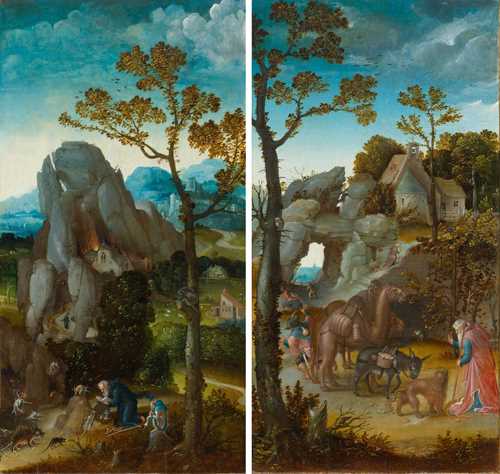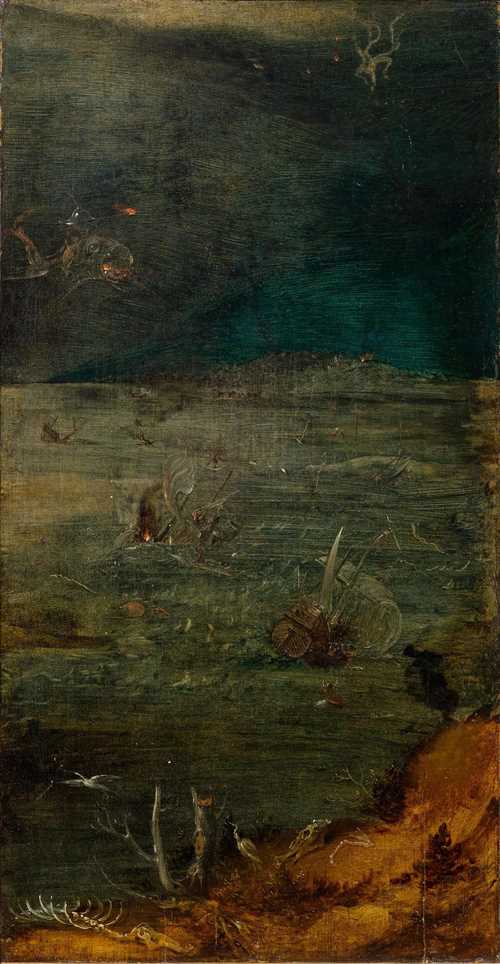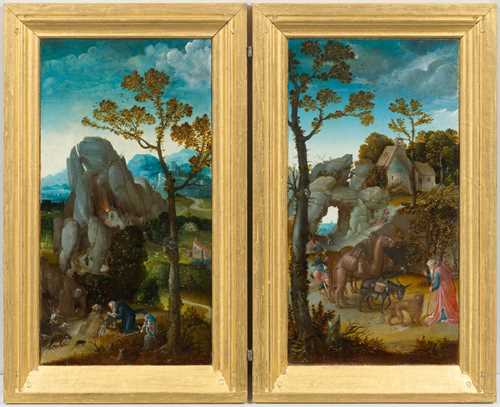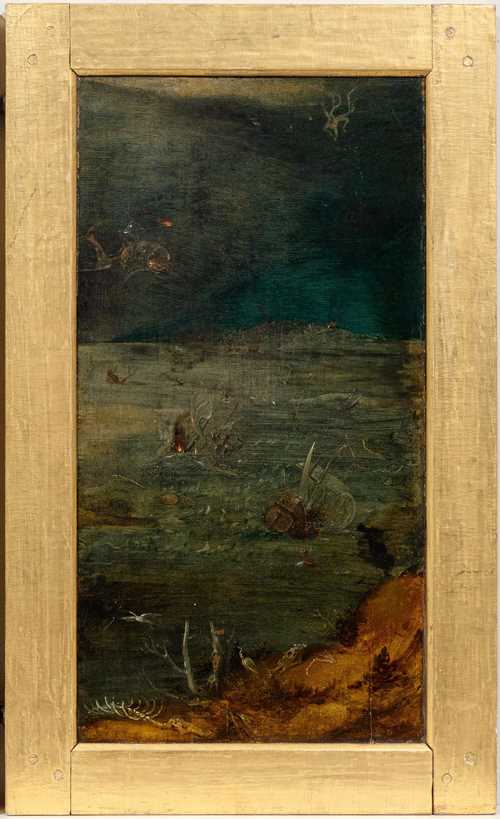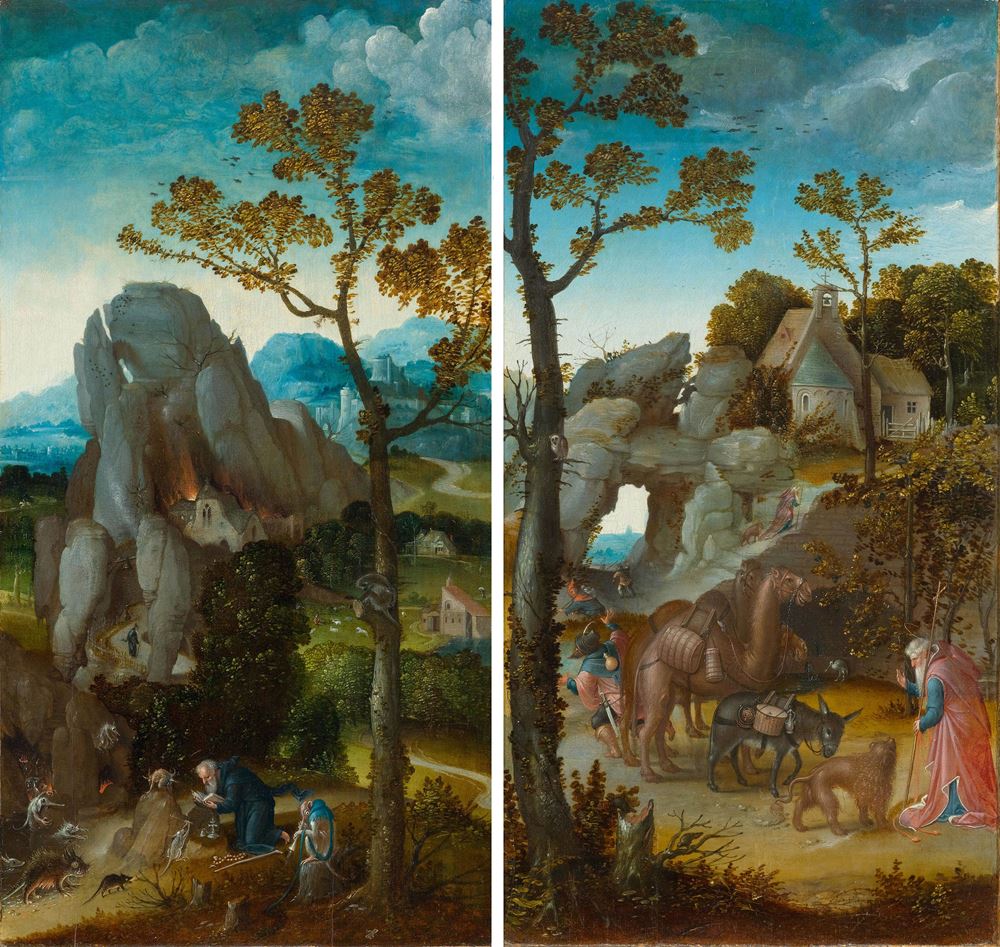
拍品 3019* - A190 大师画作 - Freitag, 27. September 2019, 02.00 PM
JAN WELLENS DE COCK
(Leiden c. 1470–1521 Antwerp)
Two altar panels: The Temptation of Saint Anthony (verso: A night scene with mythical creatures)/Saint Jerome in a landscape.
Oil on panel.
Each 48.5 × 25.5 cm.
Provenance (Saint Anthony):
- Sale Mercier-Velliet-Thulllier, 20.1.1991, lot 140 (attributed to the workshop of Pieter Huys).
- European private collection.
Provenance (Saint Jerome):
- J. Hauptman, Paris 1891.
- J. Zuercher, Amsterdam.
- Geza Solpray, Paris, 1948.
- Newhouse Galleries, New York, 1958.
- Sale Christie's, New York, 26.1.2001, lot 126 (as by Jan Wellens de Cock).
- European private collection.
Exhibited:
Splendeurs du maniérisme en Flandre 1500–1575, Musée de Flandre, Cassel, 4.5.–29.9.2013, no. 50 (both panels together as by Jan Wellens de Cock).
Literature:
- Marc Rudolf De Vrij: Jan Wellens de Cock: Antwerp Mannerist Associate, Amsterdam 2009, p. 202, cat. no. RA 20 (Saint Jerome, as dismissed attribution to Jan Wellens De Cock).
- Sandrine Vézilier-Dussart (ed.): Splendeurs du maniérisme en Flandre 1500–1575, Cassel 2013, cat. no. 50 (as by Jan Wellens de Cock).
These two impressive panels of extremely high quality were once a part of a larger work, and most likely served as wings of a triptych. Separated sometime before 1891, they were recently reunited by a private collector.
Hermit saints, especially Saint Anthony and Saint Jerome, were particularly appreciated in the later 15th and early 16th centuries. Withdrawing from the secular life of cities, they settled in the desert to dedicate themselves entirely to prayer and Christian devotion. They were often represented in Netherlandish and Flemish painting in particular, including works by Hieronymus Bosch (1450-1516). The Temptation of Saint Anthony was a commonly employed subject, based on an extensive iconographic tradition, whereas the scene from the story of Saint Jerome depicted on the right panel is rather rare. Saint Jerome had healed a lion from a thorn in his paw and was subsequently accompanied by him. However, the stormy coastal landscape at night on the back of the panel of Saint Anthony is an iconographic rarity. The threatening, dark nocturnal scene of monsters and demons is heavily reminiscent of the oeuvre of Hieronymus Bosch, especially of his grisaille paintings, such as on the reverse of his famous "Garden of Earthly Delights" in the Prado, Madrid (Inv. no. 2823), and “The Flood" at the Museum Boijmans Van Beuningen, Rotterdam (Inv. no. St. 27 and St. 28). Dr. Jaco Rutgers suggests that our work was executed even before the “Storm at Sea with Shipwreck” in the Kunsthistorisches Museum, Vienna (Inv. no. GG 3558), formerly attributed to Pieter Brueghel the Elder (1525-1569) and the "Storm with a Naval Battle" in the Museo Capodimonte in Naples possibly by Herri met de Bles (1500-1555/1560), which thus far have been considered the oldest known marine representations (see comprehensive research by Dr. Jaco Rutgers, 15.6.2019).
Little is known about the life of Jan Wellens de Cock and his identity is discussed in scholarly research (see exh. cat. ExtravagAnt! A Forgotten Chapter of Antwerp Painting 1500-1530, Koninklijk Museum voor Schone Kunsten Antwerpen 2005 / Bonefantenmuseum Maastricht 2006, p. 220). Entries from the years 1506 and 1516 of the Antwerp painters' guild verify his activity as a teacher and his function as dean of the guild, which he shared with his colleague Joos van Cleve (1485-1540). Amongst others, de Cocks' sons, Hieronymus (1518-1570) and Matthys (1505-1548), trained in his workshop, the former becoming not only known as a painter and engraver, but also advancing to become the most important publisher of the 16th century and instrumental for the distribution of drawings and engravings, such as those of his former apprentice Pieter Brueghel the Elder (1525/30-1569). As there are hitherto no known signed works by the artist, Max J. Friedländer has reconstructed the oeuvre of Jan Wellens de Cock based on the painting "Landscape with Saint Christopher", which was reproduced in one engraving and signed "Pictum J. Kock" (see Max J. Friedländer: Early Netherlandish Painting, Vol. XI: The Antwerp Mannerists/Adriaen Ysebrant (ed. by Henri Pauwels), Leiden / Brusseles 1974, p. 37–43 and 78–79). Not only the theme of this picture, another hermit, corresponds to our depiction of Saint Anthony and Saint Jerome, but many stylistic similarities are also apparent. The heavy cloud cover in the sky of the Saint Christopher is also found in our panels, as well as the schematic appearance of the leaves in places on the trees. The white accents of light on the cloak of Christopher can be found on the shoulders of our Saint Jerome. The execution of the secondary figures, which appear somewhat unnatural in places, are characteristic of Jan Wellens de Cock. The successive placement of the two camels can also be found in a depiction of Saint Jerome in a cave, located in the Museum für Angewandte Kunst in Cologne (Inv. no. KGM 1072).
Jan Wellens de Cock is among a group of painters known as the Antwerp Mannerists. Their work flourished in a cultural climate shaped by the economic and mercantile power of the undisputed commercial centre of Europe at that time. Masters such as Goossen van der Weyden (c. 1465-1538), the early Jan Gossaert (1478-1532), Jan de Beer (c. 1475-before 1528), Herri met de Bles (1500-1555/1560) and Jan Meyden (1500/02-1559/60) are among the protagonists of the Antwerp Mannerists. With them, de Cock shared a preference for exaggerated figural forms, rich costumes and strong colours, likewise evident in the work presented here.
CHF 180 000 / 280 000 | (€ 185 570 / 288 660)
以瑞士法郎銷售 CHF 522 800 (包含買家佣金)
所有信息随时可能更改。

